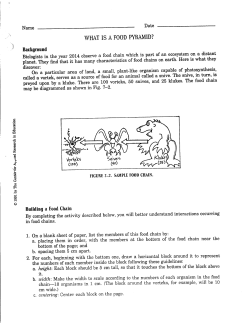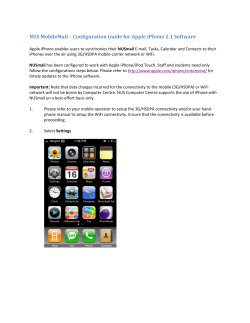
Economic Globalization – scene setting
Economic Globalization – scene setting Professor Louis Brennan Director Institute for International Integration Studies, Trinity College Dublin Where in the world??? • “An American worker running Oracle’s database software with Windows on a Dell computer with a Pentium IV microprocessor who takes Prozac in the morning and Viagra at night could have received all those products from ….” (Washington Post report, 2001) 2 Globalization (a la Thomas Friedman) • A dynamic phenomenon • Inexorable integration of markets, nation-states and technologies • Enabling individuals, corporations & nation states to reach around the world further, faster, deeper and cheaper 3 The Enactment of Globalization • Globalisation is enacted via the flows of materials, investment, information, knowledge, finance and peoples across borders. • International integration represents the ongoing outcome of the process of globalisation. Enablers and Outcomes of Globalization • Opening, deregulating and privatizing of economies • Advances in Information and Communication technologies • Advances in Transportation Systems Giving rise to new modes of organising Outsourcing Off-shoring Open-sourcing In-sourcing Supplychaining and Informing and Communicating for free • and with ensuing complexity fuelled by interdependencies and blurring of boundaries 5 The core issue • The world has never been so interconnected and integrated • As a result it has never been so interdependent • Yet, our knowledge around, and understanding of this interdependent world are based on models and insights that reflect a very different reality • For example we still tend to base much of our analysis and thinking on the obsolete and ultimately (in the context of an interdependent world) destructive notion of self-interest leading to disagreement, conflict and war when such interdependency calls for models and systems that are based on mutuality • This is noted in the General Theory where Keynes states that “The mercantilists were under no illusions as to the nationalistic character of their policies and their tendency to promote war.” (pg.348) The Challenge • The world is paying a heavy price for this knowledge deficit with our global financial system on life support, the sustainability of the planet in question and, as we are now experiencing in Europe, past progress in integration under threat • There is an urgent need for researchers to develop new paradigms and new understandings that can address in their varying ways the challenges of interdependency arising from International Integration • Davos 2012 set as its theme “The great transformation; shaping new models” • “We desperately need new models” - Klaus Schwab Southern Multinationals* OFDI from developing countries to developed countries North North South OFDI Recent Conventional More Recent Common South There is a data deficit characterised by a lack of reliable and consistent data in terms of the emergence of Southern Multinationals and their Impact on Europe that needs to be addressed– The Emergence of Southern Multinationals: Their Impact on Europe, L. Brennan (2011) *COST Action IS0905: The Emergence of Southern Multinationals and their Impact on Europe. North: Developed countries South: Developing countries 8 Global Value Chains • • • • • • Global Value Chains represent the enactment of globalisation. Globalisation at its heart is about flows: flows of materials, goods, information, knowledge, finance and people. Global Value Chains are the basis of such flows. Ongoing construction, deconstruction and reconstruction of such chains provides the infrastructure through which globalisation is enabled. The design, configuration and coordination of such chains to achieve maximum business performance are central to the role of MNEs. Integrating emerging technologies into such chains to create symbiotic business systems that yield maximum performance is the key to competitive advantage in today’s globalised world GLOBAL VALUE CHAINS • Global value chains make it possible to bring together all the raw materials & components that combine to make a product or service; to deliver it into use through distribution systems; to support users on a 24 hour basis; and to recover and integrate residue into a waste stream. • These chains span the world, so that even mundane items now commonly involve the coordination of flows of goods, information, finance and people across several continents while navigating customs crossings, security screenings and identity verification. • A global value chain may involve American designers, Indian software writers, Asian manufacturers and European system integrators and support provision Global Flows – A DVD Player Source: Wall Street Journal, May 18, 2009 11 Global Value Chains • Global value chains (GVCs) are ‘organizational systems’ a. that operate across multiple nations; b. that are integrated c. whose global integration is complex d. whose technology base, or ‘engine’, is Information & Communication Technologies e. that drive firm-level competitive advantage through integrating global and local competitive and comparative advantages (firm specific & location specific advantages) • f. that build & defend longer term competitive advantage through complex and hard to imitate firm-level assets / capabilities • g. that evolve through stages of development, or may be ‘born global’ • h. that incorporate ‘traditional’ or ‘conventional’ activities and functions but also involve ‘whole system’ activities from sourcing to customer support and embody materials, information, financial and people flows and assets Complexity – the case of Findus UK Source: FT, February 11, 2013 Complexity of Global Value Chains • The complexity of these chains may be seen, for example, in the activities necessary to bring a new automobile to market. • Flows of ore, steel, petrochemicals, performance plastics, glass, paint, rubber, mechanics, electrics, electronics, software, upholstery, to name just some elements, must be coordinated to take the form of automobile parts, components and sub-systems • And must all converge just-in-time in an assembly plant to be fashioned into an automobile • And then dispersed geographically again through distributors, dealerships and internet vendors into final ownership and continuing service in the hands of individuals throughout the world The Global Component Network for Ford’s European Manufacturing of the Escort Source: International Business, Daniels et al. UNCTAD’s “Global Value Chains and Development” reports that .. • Some 28% of the value of cross-border trade in goods and services is overstated as a result of double or multiple counting • 80% of global trade is accounted for by value chains administered by MNEs such that global investment and trade “are thoroughly entwined international production networks” • Almost half the value added inputs to exports are from service sector activities, although the data on exports lists services as contributing to only 20% of gross exports worldwide Value Value Creation and Capture Consumer surplus Profit Value capture Contributing to operating profits by charging for firm’s value proposition Value Creation By meeting customers needs through firm’s value positions. Total Value Price Cost Value Delivery Configuration of internal and external capabilities to deliver customer value. Benefit Cost Fig. 11.4: The Value Chain Framework Source: International Business, Daniels et al. 19 The Value Chain • Takes an end to end perspective in terms of activities, resources, assets, capabilities, relationships and financial and operating data • Facilitates thinking holistically across the chain and • Identifying opportunities in terms of new ideas and innovations which could emerge from a questioning of what is, what is not and what could be Capturing Value • Slicing and Dicing the Value Chain • Extracting Value from other stages of the Value Chain - outsourcing • Repositioning on the Value Chain – Stan Shih’s Smiling Curve • Tightly integrate and streamline the Value Chain by collaborating and sharing with Partners to establish a win-win for all. 21 Stan Shih’s ‘Smiling Curve’ Value Added Software E-commerce CPU Distribution DRAM LCD Marketing ASIC Monitor Local Sourcing Motherboard Local Assembly Components Source; Shih, Acer. Assembly Distribution 22 The Multinational Enterprise and Value Chain Configuration • Multinational Enterprises (MNEs) are one of the, if not the most significant actors in today’s globalised world. • MNEs determine Value Chain configurations i.e. the way that the activities of the value chain are spatially arranged taking account of a multiplicity of factors that can include • • • • • • • • • cost factors [wage rates, productivity, inflation, etc.] business environments [political & economic risk] regulatory and tax considerations technology cluster effects [related value creation activities] logistics [value-to-weight ratio, just-in-time practices] degree of digitization [virtual value creation] economies of scale [unit cost reductions] customer needs [buyer-related support activities] 23 Global Value Chains Global Fragmentation of Production Shareholder Value Offshoring Internal Middle-men Outsourcing Contractors Supporting and related services Opening, Deregulation & Privatization of Economies, Advances in ICT and Transportation The Globalization of Production Source: FT, March 3, 2010 Global Production • Captures advantages such as stronger price competitiveness and adaptability to local markets and at the same time • Avoids trade barriers and foreign exchange losses • However, as the production base expands overseas and supply lines become more diverse, difficult to transplant tacit knowledge into overseas production sites and to secure efficiency in inventory and quality control. • Growing risk of technology being leaked. 26 The Global Fragmentation of Production • Manufacturing has been transformed over recent decades with offshoring including outsourcing contributing to dramatic changes in the Manufacturing landscape. • Manufacturing has migrated to low cost economies while many established product firms in the developed economies have contracted out their manufacturing to specialist manufacturing firms. • Today we have globalised manufacturing networks involving many source locations and actors so that the concept of “made in the world” has entered the discourse. • Concurrent with the hollowing out of their manufacturing activities, product firms have sought to drive value creation by embracing new business models that incorporate elements of servitization. • At the same time, manufacturing faces challenges in responding to green related issues whether stemming from changes in regulation or customer sentiment while the uptake of 3D/additive manufacturing offers new possibilities for the configuration of manufacturing activities and customer engagement. Global Fragmentation is not without Risks • The past decades has seen the propagation of value chains to become global multi-tiered in nature. While advantages have accrued to Brand Owners and Original Equipment Manufacturers (OEMs) in terms of lower costs and higher profits, the global propagation and dispersion of value chains is not risk free. • Some recent high profile examples of risks materializing include the spotlight on working conditions at Foxconn Technology – Apple’s major supplier, and the deadly fire at a textile manufacturer in Bangladesh this past November that reportedly made clothes destined for Walmart. • Yet most Brand Owners and OEMs assert that that they take considerations other than cost into account when contracting with suppliers. The Foxconn Empire Source: FT, January 3, 2013. Fragmentation of production: the example of the Boeing 787 Dreamliner Wing box: Mitsubishi Heavy Industries (Japan) Wing ice protection: GKN Aerospace (UK) Centre fuselage: Alenia Aeronautica (Italy) Escape slides: Air Cruisers (USA) Rear fuselage: Boeing South Carolina (USA) Vertical Stabiliser: Boeing Commercial Airplanes (USA) Forward fuselage: Kawasaki Heavy Industries (Japan) Spirit Aerosystems (USA) Lavatories: Jamco (Japan) Doors & windows: Zodiac Aerospace (USA) PPG Aerospace (USA) Raked wing tips: Korean Airlines Aerospace division (Korea) Flight deck seats: Ipeco (UK) Flight deck controls: Esterline (USA), Moog (USA) Horizontal Stabiliser: Alenia Aeronautica (Italy) Centre wing box: Fuji Heavy Industries (Japan) Aux. power unit: Hamilton Sundstrand (USA) Passenger doors: Latécoère Aéroservices (France) Cargo doors: Saab (Sweden) Source: www.newairplane.com Prepreg composites: Toray (Japan) Landing gear: Messier-Dowti (France) Electric brakes: Messier-Bugatti (France) Tires: Bridgestone Tires (Japan) Engines: GE Engines (USA), Rolls Royce (UK) Engine nacelles: Goodrich (USA) Tools/Software: Dassault Systemes (France) Navigation: Honeywell (USA) Pilot control system: Rockwell Colins (USA) Wiring: Safran (France) Final assembly: Boeing Commercial Airplanes (USA) Boeing and Outsourcing • While Boeing has progressively increased its outsourcing, Japanese suppliers in particular have played an increasingly bigger role in building Boeing aircraft, supplying : 15 percent of the 767 jet, 21 percent of the 777, and 35 percent of the 787. • But the experience with the development and production of the 787 suggests that are limits to the effective management of the complexity that such large scale outsourcing entails especially when modularity involving design and manufacturing is low. And more broadly the Globalization of Production has been linked to …… • The erosion and in some cases the extinction of the “industrial commons” in some sectors in some geographies • The hollowing out of the middle class and the rise of inequality in the developed world • A rise in unemployment • But with development benefits for many low cost economies The Smart Phone 34 Source: New York Times, July 5, 2010. The iPhone and the US-China Trade Deficit* • Most of the bilateral deficit associated with iPhone trade does not originate in China as workers there contribute a very small portion of the value-added to an iPhone sold in markets. • Being solely an iPhone assembly center, China first imports all components and then re-exports them as the final assembled product to the US. • It costs only US$6.50 per unit to assemble all parts and components into a ready to use iPhone. • The assembly cost accounts for merely 3.6% of the total manufacturing cost. • The imported components from other countries greatly inflate the export value. *How the iPhone widens the United States Trade Deficit with the People’s Republic of China, Yuqing Xing and Neal Detert, ADBI Working Paper Series No. 257, December 2010. 35 Shareholder Value • The Value captured by Apple with its iPhone and other products and services is reflected in its huge profits • While Apple’s level of Value Capture is possible within the context of globalisation, it is driven by the overriding embrace of the primacy of shareholder value and its maximization • Maximizing shareholder value has been core to enterprise strategy for some three decades now • ‘While shareholder value continues to have primacy over the interests of other stakeholders, it is axiomatic that income inequality will continue to rise regardless of the pace of globalisation or the rate of technological change.’ – Louis Brennan, Financial Times, February 2007. Administrative Arbitrage on the part of MNEs creates data measurement challenges • Tax Strategies of MNEs: Transfer Pricing and the measurement of trade “Roundtrip” Investments and the measurement of FDI “Addressing Base Erosion and Profit Shifting” • “by searching through the IMF Co-ordinated Direct Investment Survey (CDIS), it emerges that in 2010: Barbados, Bermuda and the British Virgin Islands received more FDIs (combined 5.11% of global FDIs) than Germany (4.77%) or Japan (3.76%). These three jurisdictions made more investments into the world (combined 4.54%) than Germany (4.28%). On a country-by-country position, in 2010 the British Virgin Islands were the second largest investor into China (14%) after Hong Kong (45%) and before the United States (4%). Similar data exists in relation to other countries, for example Mauritius is the top investor country into India (24%), while Cyprus (28%), the British Virgin Islands (12%), Bermuda (7%) and the Bahamas (6%) are among the top five investors into Russia.” (OECD, 2013) Signs of Reversal??? • “The ideal strategy for a global company would be to put every factory it owned on a barge and float it around the world, taking advantage of short-term changes in economies and exchange rates” - Jack Welch, former CEO GE. • More recently, there have been suggestions around the possibilities of a manufacturing renaissance in those economies which experienced a hollowing out of manufacturing over the past decades. • An embrace of near-shoring and re-shoring has recently been observed in the case of a number of firms • Apart from cost and nimbleness considerations a number of other factors obtain viz. an increasing consciousness of the vulnerabilities of globally dispersed value chains recognition of the benefits of co-location of design and manufacturing functions an awareness of the limits to manufacturing fragmentation • Suggesting that we are close to a tipping point in terms of the global dispersion of manufacturing activities. Thank You
© Copyright 2025



















